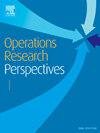组合性检测中的新捷径策略:分解以获得更快的正证书
IF 3.7
4区 管理学
Q2 OPERATIONS RESEARCH & MANAGEMENT SCIENCE
引用次数: 0
摘要
共生性是对称矩阵的一种np难检验性质。然而,对于一些困难优化问题的二次逼近,它在紧界中起着至关重要的作用。在本文中,我们提出了新的有前途的捷径策略,以系统的方式利用有利实例,使用基于允许重叠的思想的分解策略,较小的块,从给定矩阵的条目的有利符号结构中获益。这种方法的工作假设是社区中常见的经验观察,即对于共同性的检测,否定证明比肯定证明更容易获得。首先,对精心安排的随机生成的实例的实证结果似乎证实了我们的方法。本文章由计算机程序翻译,如有差异,请以英文原文为准。
Novel shortcut strategies in copositivity detection: Decomposition for quicker positive certificates
Copositivity is a property of symmetric matrices which is NP-hard to check. Nevertheless, it plays a crucial role in tight bounds for conic approaches of several hard optimization problems. In this paper, we present novel promising shortcut strategies to exploit favorable instances in a systematic way, using decomposition strategies based upon the idea to allow for overlapping, smaller blocks, profiting from a beneficial sign structure of the entries of the given matrix. The working hypothesis of this approach is the common empirical observation in the community that for detection of copositivity, a negative certificate is easier to obtain than a positive one. First empirical results on carefully orchestrated randomly generated instances seem to corroborate our approach.
求助全文
通过发布文献求助,成功后即可免费获取论文全文。
去求助
来源期刊

Operations Research Perspectives
Mathematics-Statistics and Probability
CiteScore
6.40
自引率
0.00%
发文量
36
审稿时长
27 days
 求助内容:
求助内容: 应助结果提醒方式:
应助结果提醒方式:


